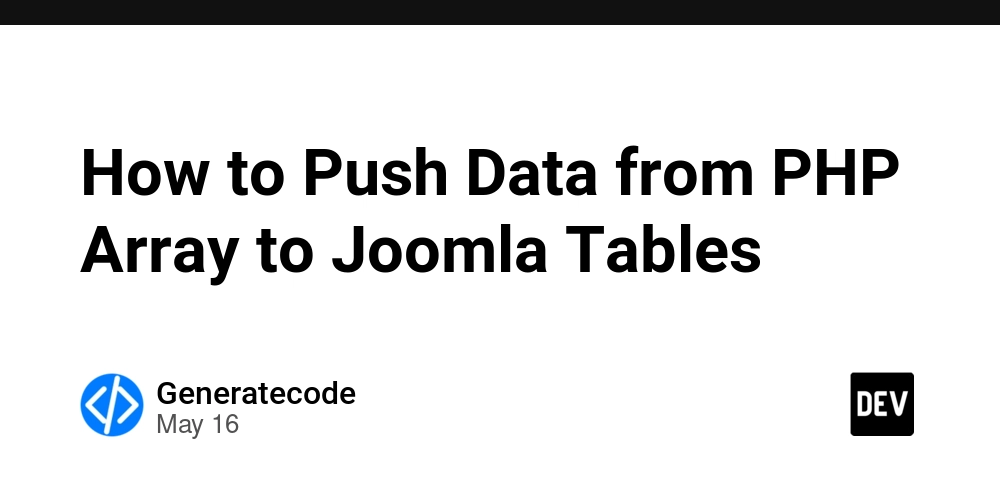How to Push Data from PHP Array to Joomla Tables
In this article, we will explore how to push data from a PHP array into multiple Joomla tables that share similar but not identical structures. If you're working with Joomla and need to insert values into different tables based on specific column mappings, this guide will provide you with step-by-step instructions. Understanding the Data Structure To start, we have an array with numerical data structured as follows: $data[1] = 1; $data[2] = 2; $data[3] = 3; This array contains three numeric values. In our case, we want to distribute these values across five different Joomla tables, but each table may only have certain columns available. Why You Need to Consider Table Structures Joomla, like many content management systems (CMS), often involves various tables that may not have identical column structures. This means that when you're inserting data, you need to ensure that the specific columns of each table are being populated correctly. Failing to do this may result in SQL errors or data inconsistency. Step-by-Step Solution To effectively push the $data array into five different Joomla tables, we can use a loop to iterate through each table while mapping the relevant data to the appropriate columns. Step 1: Define Your Tables and Their Mappings Assuming we have five tables that accept different combinations of columns, we should define the tables and the columns they expect: $tables = [ ['name' => 'table1', 'columns' => ['column1', 'column2']], ['name' => 'table2', 'columns' => ['column2', 'column3']], ['name' => 'table3', 'columns' => ['column3', 'column1']], ['name' => 'table4', 'columns' => ['column1']], ['name' => 'table5', 'columns' => ['column2', 'column3']] ]; Step 2: Prepare the Database Connection Make sure you have your Joomla database connection ready. Joomla provides a built-in method for interacting with the database, which you can utilize as follows: $db = JFactory::getDbo(); Step 3: Insert Data into Each Table Next, we create a function to insert the data based on the defined mappings. We will loop through each table and push the appropriate data: foreach ($tables as $table) { $columns = $table['columns']; $values = []; foreach ($columns as $column) { // Map array values to columns based on their index switch($column) { case 'column1': $values[] = $data[1]; break; case 'column2': $values[] = $data[2]; break; case 'column3': $values[] = $data[3]; break; } } // Create a query object $query = $db->getQuery(true); // Insert values into the table $query->insert($db->quoteName($table['name'])) ->columns($db->quoteName($columns)) ->values(implode(',', array_map([$db, 'quote'], $values))); // Execute the query $db->setQuery($query); try { $db->execute(); } catch (RuntimeException $e) { // Handle exceptions echo 'Error: ' . $e->getMessage(); } } Conclusion In summary, by preparing your data properly and understanding the structure of your Joomla tables, you can effectively push data from a PHP array into multiple tables. This approach allows you to maintain data integrity while working with variable column mappings across different tables in Joomla. This method not only enhances your application's performance but also ensures accurate data storage. Frequently Asked Questions What if my data array is dynamic? You can adapt the code by dynamically generating the $data array before entering the loop to handle changing values. Can I use this method for all Joomla tables? While this method works for custom data insertion, ensure that you respect Joomla's database schema and avoid overwriting existing data unintentionally. Is there a way to check for existing data before insertion? Yes, you can add a preliminary SELECT query to check if the entry exists in the table before executing an insert to avoid duplication.

In this article, we will explore how to push data from a PHP array into multiple Joomla tables that share similar but not identical structures. If you're working with Joomla and need to insert values into different tables based on specific column mappings, this guide will provide you with step-by-step instructions.
Understanding the Data Structure
To start, we have an array with numerical data structured as follows:
$data[1] = 1;
$data[2] = 2;
$data[3] = 3;
This array contains three numeric values. In our case, we want to distribute these values across five different Joomla tables, but each table may only have certain columns available.
Why You Need to Consider Table Structures
Joomla, like many content management systems (CMS), often involves various tables that may not have identical column structures. This means that when you're inserting data, you need to ensure that the specific columns of each table are being populated correctly. Failing to do this may result in SQL errors or data inconsistency.
Step-by-Step Solution
To effectively push the $data array into five different Joomla tables, we can use a loop to iterate through each table while mapping the relevant data to the appropriate columns.
Step 1: Define Your Tables and Their Mappings
Assuming we have five tables that accept different combinations of columns, we should define the tables and the columns they expect:
$tables = [
['name' => 'table1', 'columns' => ['column1', 'column2']],
['name' => 'table2', 'columns' => ['column2', 'column3']],
['name' => 'table3', 'columns' => ['column3', 'column1']],
['name' => 'table4', 'columns' => ['column1']],
['name' => 'table5', 'columns' => ['column2', 'column3']]
];
Step 2: Prepare the Database Connection
Make sure you have your Joomla database connection ready. Joomla provides a built-in method for interacting with the database, which you can utilize as follows:
$db = JFactory::getDbo();
Step 3: Insert Data into Each Table
Next, we create a function to insert the data based on the defined mappings. We will loop through each table and push the appropriate data:
foreach ($tables as $table) {
$columns = $table['columns'];
$values = [];
foreach ($columns as $column) {
// Map array values to columns based on their index
switch($column) {
case 'column1':
$values[] = $data[1];
break;
case 'column2':
$values[] = $data[2];
break;
case 'column3':
$values[] = $data[3];
break;
}
}
// Create a query object
$query = $db->getQuery(true);
// Insert values into the table
$query->insert($db->quoteName($table['name']))
->columns($db->quoteName($columns))
->values(implode(',', array_map([$db, 'quote'], $values)));
// Execute the query
$db->setQuery($query);
try {
$db->execute();
} catch (RuntimeException $e) {
// Handle exceptions
echo 'Error: ' . $e->getMessage();
}
}
Conclusion
In summary, by preparing your data properly and understanding the structure of your Joomla tables, you can effectively push data from a PHP array into multiple tables. This approach allows you to maintain data integrity while working with variable column mappings across different tables in Joomla. This method not only enhances your application's performance but also ensures accurate data storage.
Frequently Asked Questions
What if my data array is dynamic?
You can adapt the code by dynamically generating the $data array before entering the loop to handle changing values.
Can I use this method for all Joomla tables?
While this method works for custom data insertion, ensure that you respect Joomla's database schema and avoid overwriting existing data unintentionally.
Is there a way to check for existing data before insertion?
Yes, you can add a preliminary SELECT query to check if the entry exists in the table before executing an insert to avoid duplication.








![Epic Games: Fortnite is offline for Apple devices worldwide after app store rejection [updated]](https://helios-i.mashable.com/imagery/articles/00T6DmFkLaAeJiMZlCJ7eUs/hero-image.fill.size_1200x675.v1747407583.jpg)































































































































































![[The AI Show Episode 146]: Rise of “AI-First” Companies, AI Job Disruption, GPT-4o Update Gets Rolled Back, How Big Consulting Firms Use AI, and Meta AI App](https://www.marketingaiinstitute.com/hubfs/ep%20146%20cover.png)


















































































































































































































































.png?width=1920&height=1920&fit=bounds&quality=70&format=jpg&auto=webp#)























![[Virtual Event] Strategic Security for the Modern Enterprise](https://eu-images.contentstack.com/v3/assets/blt6d90778a997de1cd/blt55e4e7e277520090/653a745a0e92cc040a3e9d7e/Dark_Reading_Logo_VirtualEvent_4C.png?width=1280&auto=webp&quality=80&disable=upscale#)











































































-xl-(1)-xl-xl.jpg)










![How to upgrade the M4 Mac mini SSD and save hundreds [Video]](https://i0.wp.com/9to5mac.com/wp-content/uploads/sites/6/2025/05/M4-Mac-mini-SSD-Upgrade-Tutorial-2TB.jpg?resize=1200%2C628&quality=82&strip=all&ssl=1)
![‘Apple in China’ book argues that the iPhone could be killed overnight [Updated]](https://i0.wp.com/9to5mac.com/wp-content/uploads/sites/6/2025/05/Apple-in-China-review.jpg?resize=1200%2C628&quality=82&strip=all&ssl=1)




![What’s new in Android’s May 2025 Google System Updates [U: 5/16]](https://i0.wp.com/9to5google.com/wp-content/uploads/sites/4/2025/01/google-play-services-1.jpg?resize=1200%2C628&quality=82&strip=all&ssl=1)












![iPhone 17 Air Could Get a Boost From TDK's New Silicon Battery Tech [Report]](https://www.iclarified.com/images/news/97344/97344/97344-640.jpg)
![Vision Pro Owners Say They Regret $3,500 Purchase [WSJ]](https://www.iclarified.com/images/news/97347/97347/97347-640.jpg)
![Apple Showcases 'Magnifier on Mac' and 'Music Haptics' Accessibility Features [Video]](https://www.iclarified.com/images/news/97343/97343/97343-640.jpg)
![Sony WH-1000XM6 Unveiled With Smarter Noise Canceling and Studio-Tuned Sound [Video]](https://www.iclarified.com/images/news/97341/97341/97341-640.jpg)










































![Apple Stops Signing iPadOS 17.7.7 After Reports of App Login Issues [Updated]](https://images.macrumors.com/t/DoYicdwGvOHw-VKkuNvoxYs3pfo=/1920x/article-new/2023/06/ipados-17.jpg)




























